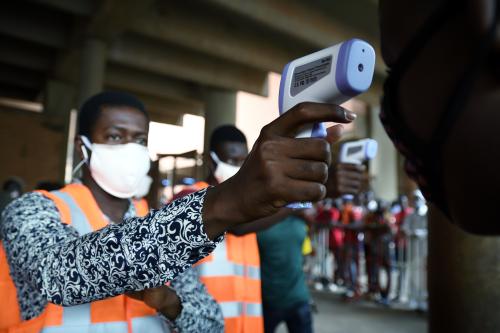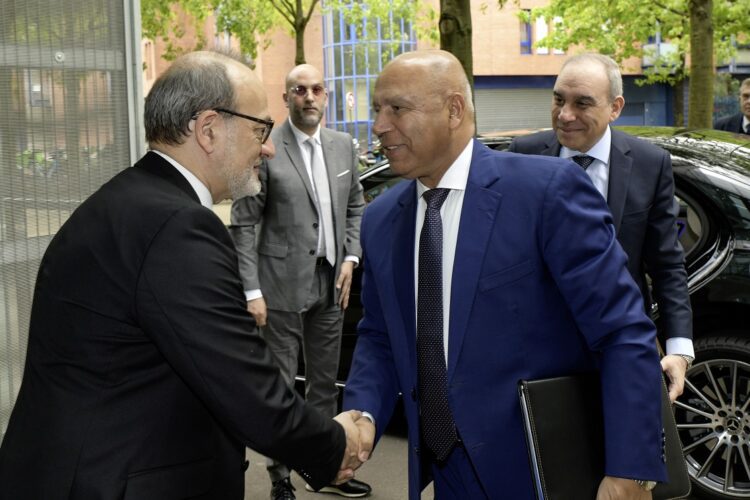The first two COVID-19 cases in Ghana were confirmed on March 12, 2020. As of July 23, 2020, there have been 32,969 confirmed COVID-19 cases with 168 deaths. The virus has disproportionately affected southern Ghana—52 percent of cases are in Greater Accra (Table 1). With a population of about 30 million—the 10th largest in sub-Saharan Africa—Ghana now has the fourth highest number of cases in sub-Saharan Africa (after South Africa, Egypt, and Nigeria). The reason is that Ghana has one of the highest testing rates when compared to other African countries.
Table 1. Half of Ghana’s COVID-19 cases are in and around the capital city
Region
Cases
Greater Accra
17,152
Ashanti Region
7,866
Western
2,544
Central
1,355
Eastern
1,234
Volta
579
Bono East
436
Bono
426
Western North
353
Northern
302
Upper East
282
Oti
174
Ahafo
121
Upper West
79
Savannah
57
North East
9
Data source: Ghana Health Service website.
Note: See also this animated progression created by Siddharth Dixit.
WHAT HAS THE GOVERNMENT DONE?
Clear communications
Since the start of Ghana’s COVID-19 outbreak on March 12 2020, President Akufo-Addo has addressed the nation 13 times. On April 5, the government announced five key objectives in Ghana’s fight against COVID-19: 1) limit and stop the importation of the virus; 2) contain the spread of the virus; 3) provide adequate care for patients with the virus; 4) limit the social and economic impacts of the virus; and 5) expand domestic capability and deepen Ghana’s self-reliance. To achieve these objectives, Ghana has introduced a range of public health, health system and socio-economic policy measures. Figure 1 summarizes the timeline of the main measures.
Figure 1. Timeline of main policy steps taken by the government of Ghana
Stepwise lockdown, accompanied by testing and tracing
The government of Ghana announced social distancing measures on March 15, and a day later, it restricted foreign nationals from entering the country. Starting March 22, all air, land, and sea border checkpoints were closed, and on March 27, a partial lockdown was imposed in several big cities, which lasted for over three weeks.
As of June 27, 294,867 tests had been conducted in Ghana. At the beginning of the pandemic, only three laboratories performed COVID-19 tests in Ghana, and this capacity has now been expanded to 10 labs. A “pooled testing” approach is being used, namely combining samples from multiple people and testing them together to increase testing capacity. The ministry of health has also used drones to collect COVID-19 samples from more than 1,000 health facilities.
The government started contact tracing immediately after the first cases were confirmed. All known contacts of people who were confirmed positive were tested, which was helpful in initially controlling the spread. A new contact-tracing app, the COVID-19 Tracker App was launched to help people assess and self-report symptoms, trace contact with infected people, and help infected people get access to health services.
Adapting health facilities and incentivizing health workers
7,791 health facilities and 18 intensive care units (ICUs) were used to respond to COVID-19. In late April, the government announced that three new infectious disease centers would be built. On April 5, the president announced four incentives for health workers:
Exemption from the payment of tax on their employment emoluments for a three-month period starting April 2020. (This was extended for another three months by the president in his 13th address.)
A daily allowance of 150 Ghanaian cedis (approximately $26) for workers doing contact tracing.
An additional allowance of 50 percent of monthly basic salary for front-line health workers for four months starting March. The allowance has since been extended by three months.
An insurance package, with an assured sum of 350,000 cedis (approximately $60,345). It was increased to 10 million cedis on July 23.
Financial measures and socioeconomic welfare protection
The government has introduced several measures to mitigate the social and economic impacts of COVID-19. It launched the COVID-19 Alleviation Fund to raise funds for the response including supporting businesses and other social interventions. The government covered water and electricity bills for the population (100 percent for the very poor and 50 percent for all others including businesses), provided food assistance, supported small and medium-scale enterprises. All testing and treatment for COVID-19 is fully covered by the State government in Ghana.
According to the International Monetary Fund (IMF), the government plans to cut spending on goods and services, transfers, and capital investment by at least 0.3 percent of GDP to compensate for COVID-19 spending. On March 18, the Monetary Policy Committee (MPC) of the Bank of Ghana cut the policy rate by 150 basis points to 14.5 percent, and took measures to mitigate the impact of the pandemic shock, such as lowering the primary reserve requirement and the capital conservation buffer. At its May 15 meeting, the MPC decided to launch a special COVID-19 Relief Bond program with a size of 10 billion cedis (approximately $1.73 billion) in order to make up the financing gap.
WHAT MORE COULD BE DONE?
Increase testing capacity and strengthen disease surveillance
Since May 31 when Ghana eased the lockdown, new daily cases are on the rise. Since June 15, students have also started coming back to school, which could add to the risk of increase in viral transmission. To better control the spread of COVID-19, it is essential for the government to ramp up the capacity and scope of contact tracing, testing, and routine surveillance. Second, restrictions should be eased slowly in a stepwise approach with close monitoring. Any decision to reduce restrictions should be based on surveillance of the COVID-19 incidence and severity. Third, more test labs should be established as the current rate of testing is not commensurate with the growing demand for COVID-19 testing. Fourth, the government should sanitize public spaces and effectively implement public health measures such as social distancing and mask wearing. One possible strategy that could be helpful is for the government to monitor cross-city mobility and uniformly test or quarantine people coming from COVID-19 hotspots.
Improve distribution of resources and information for vulnerable populations
Many people live in slums or overcrowded settlements with little access to health services or to soap, water, and sanitation. There are also areas of high population density where many households share a single room, making physical distancing nearly impossible. Some communities have received little information about COVID-19. The lack of outreach could have led to fear of seeking testing and treatment services due to stigma and discrimination. More attention should be paid to vulnerable populations. The government should recruit and train more health workers to reach out to vulnerable communities, and regularly distribute personal protective equipment and provide sanitation services to them.
Maintain essential services for other diseases
On April 20, the Ghana Health Service reported at least 409 cases of meningitis in five regions with 40 deaths. Investigation showed that the high fatality was due to late reporting of cases, since the government was mainly focused on COVID-19 with less focus on other diseases. The public is also concerned that health facilities are occupied with patients with COVID-19, resulting in people with other diseases receiving little or no care. In the short term, the Ministry of Health and the Ghana Health Service should commit to maintain planning and financing of national health needs. The government could divide health services providers between essential services and COVID-19, design clinical pathways to prevent in-hospital infections, and ensure the supply of PPE to protect providers. It should also intensify efforts in surveillance, laboratory case detection, and case management. In the long term, the government has to build capacity for handling multiple crises.
A GOOD EFFORT—BUT GHANA CAN’T LET UP
Since the COVID-19 pandemic began, the government has implemented a range of public health and socioeconomic measures, such as using drones to deliver samples for testing, supporting front-line health workers, covering the cost for testing and treatment, and providing economic relief to citizens and enterprises. After the easing of lockdown on May 31, reopening of schools on June 15, and easing of restrictions on public transportation, tourist sites, and churches on July 26, arguments remain about whether these decisions were made based on scientific evidence or political considerations. Some have argued that political activities that come with an election year (including voter registration exercise and conduct of parliamentary primaries by the party of the ruling government) may have received considerations that likely weighed against the scientific evidence. The government will have to strengthen data systems to provide clear evidence that the science supports easing decisions. Again, Ghana needs to urgently expand testing capacity, and continue to strengthen health systems to ensure that they are up to the task of moving the response from pandemic to program mode.
Source link : https://www.brookings.edu/articles/how-well-is-ghana-with-one-of-the-best-testing-capacities-in-africa-responding-to-covid-19/
Author :
Publish date : 2020-07-28 07:00:00
Copyright for syndicated content belongs to the linked Source.





